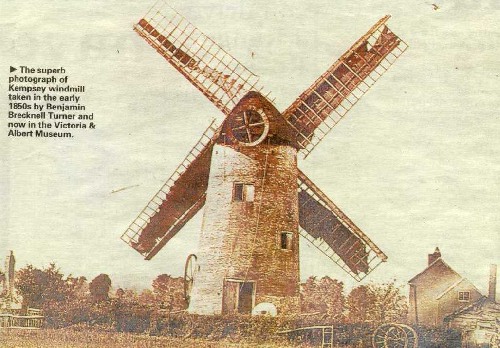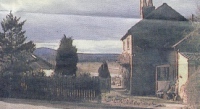Kempsey Windmill
On this page: 
On this page: 
|
This is a newspaper article from the Memory Lane column written by Michael Grundy in the Evening News of 10th March 2001, page 12.
On the face of it, because it was once the site of a wind-driven structure for milling flour, though you'd be forgiven for finding it difficult to readily confirm this fact.
The truth is that a windmill did, indeed, exist in this location for no fewer than 800 years, though the sturdy structure was pulled down 126 years ago and is obviously a landmark well out of anyone's living memory.
Fortunately, however, a superb photograph of the Kempsey windmill still survives, and such is the atmospheric beauty and rarity of the historic scene that it's one of the prized images in the photography collection of London's renowned Victoria & Albert Museum.
The photograph, as artistic as any Victorian landscape painting, was taken almost 150 years ago by one of the nation's earliest pioneer photographers, Benjamin Brecknell Turner.
It is believed he captured the Kempsey windmill on camera sometime between 1852 and 1854, making the rare image almost a century-and-a-half old!

Martin Barnes, the Victoria & Albert Museum's assistant curator of photographs, says it must certainly be the "earliest photograph" taken at Kempsey.
I learned of its existence from a chance meeting in Worcester recently with Ron Sears, whose comparatively modern bungalow home stands on the site of the Kempsey windmill.
He and wife Jess have lived in Windmill Lane, for 46 years and had a surprise visitor a few months ago, when Martin Barnes knocked on their door.
He had come up from London, in search of the site of the Kempsey windmill, featured in a valued collection of Benjamin Brecknell Turner photographs which he cares for at the V & A.
 Martin clearly identified the Sears' home and garden as having been the site for which
he was searching. Looking at the 1850s photograph, we can see, on the right, a substantial
Victorian cottage which still exists though it has since been extended and converted into
two homes - those of the Sears' neighbours, Brian and Cheryl Ballard, and Bill and Doreen
Wood-Honey.
Martin clearly identified the Sears' home and garden as having been the site for which
he was searching. Looking at the 1850s photograph, we can see, on the right, a substantial
Victorian cottage which still exists though it has since been extended and converted into
two homes - those of the Sears' neighbours, Brian and Cheryl Ballard, and Bill and Doreen
Wood-Honey.
Martin Barnes was carrying out research for a book he was compiling. Entitled Rural England Through a Victorian Lens - Benjamin Brecknell Turner, it is to be published next month by V & A Publications, price £30. Other Worcestershire villages featured in the Benjamin Turner collection are Earls Croome, Clerkenleap and Bredicot.
An exhibition to accompany the book is to be mounted at the V & A from Thursday, April 5, to Sunday, July 29, and will then go for display at the Metropolitan Museum of Art in New York.
When visiting Kempsey, Martin Barnes was also delighted to be shown a millstone in the garden of Gill Hollis, on the opposite side of Windmill Lane from the Sears. He believes it's the original millstone from the Kempsey windmill and is the one seen in the 1850s photograph, propped up near the entrance doorway!
There is evidence too, that a long section of the wall around Gill Hollis's garden may well have been constructed of bricks salvaged from the windmill when it was demolished in 1875.
Gill Hollis's late parents, Mac and Marjorie Hollis kept The Blue Bell pub at Callow End, for some years.
Judging from the adjacent cottage in the 1850s photograph, the main body of the Kempsey windmill must have been large and imposing, standing about 40 to 50ft high. Martin Barnes suggests there would have been a windmill at Kempsey as far back as the 12th Century.
Ron Sears has been a builder based in Kempsey, for many years. He followed in the footsteps of his late father, Frank Sears, who was also a builder in the village for much of his life.
Ron's mother, Mrs Flo Sears still lives at Kempsey and was featured in Memory Lane some months ago, principally in relation to her father, Ernie Watts, who kept a hardware and general stores in Friar Street, Worcester, for about 40 years in the middle of the last century.
Ron and Jess Sears' bungalow in Windmill Lane commands magnificent rear views across the Kempsey Hams and the River Severn to Callow End, Powick, the Old Hills, the Malverns, Clee Hill and the Ankerdine Hills.
Disaster strikes Kempsey Windmill
From a historical source:
1802, January 20
"A hurricane occurred, doing great damage to the houses in and around Worcester. The Windmill at Kempsey was set on fire by the sails being whirled round with so great rapidity."
Benjamin Brecknell Turner lived from 1816 to 1894, and is considered to be among the
foremost figures in art photography of the Victorian age.
He was one of the nation's earliest amateur photographers, starting in 1849, with a
licence from the inventor Fox Talbot. He travelled up and down the country with his camera
in his leisure time, taking photographs which are now looked upon as superb creative
expressions and works of art.
In locations as far afield as Devon and Yorkshire, he would haul his heavy photographic
equipment along country lanes and to secluded places in a horse-drawn cart.
There is a strong local connection with Benjamin Brecknell Turner. He married into the
eminent Chamberlain family of Worcestershire, who owned a prestigious porcelain works at
Diglis Worcester, during the late 18th and the first half of the 19th Century.
Benjamin's father-in-law Henry Chamberlain lived at Bredicot Court, just outside
Worcester, near Crowle, and the pioneer photographer paid many a holiday visit to his
wife's family home.
This explains why his pictorial legacy includes such local scenes as views of Worcester
Cathedral, Pershore Abbey, Earls Croome, Bredicot, Clerkenleap and, of course, Kempsey
windmill.
Benjamin Brecknell Turner ran a candles and saddle soap business in London's Haymarket.
His prized pictorial collection, labelled by him as Photographic Views from Nature,
remained in the Turner family until 1980, when it was bought at auction by the Victoria & Albert Museum.
The collection contains 60 images from the 1850s, almost a third of them taken in
Worcestershire. these will all go on public view together for the first time since the
1850s when exhibited at the V & A from Thursday, April 5 to Sunday, July 29, this
year, and such is the significance of the display in photographic history that it will
then go on to the Metropolitan Museum of Art in New York.
Martin Barnes of the V & A stresses that Turner is "a very important figure in
art photography and remains one of the most respected of all British photographers."
Entitled: "Hedgerow at Clerkenleap", 1852-1854 (waxed paper negative), housed in the Archives and Special Collections on the 3rd floor of the Wallace Library Photograph Collection, Rochester Institute of Technology, 90 Lomb Memorial Dr. Rochester, NY 14623 716-475-2562.
Details of the book:
Between 1852 and 1854 Benjamin Brecknell Turner compiled an album of 60 photographs, entitled Photographic Views from Nature. A superb collection of vintage pictures, now in the V&A, it forms the basis of this book and the companion exhibition to be shown at the V&A in Spring 2001 and later at the Metropolitan Museum of Art, New York.
Aside from their intriguing historical and topographical value, Turner`s photographs are also creative expressions in their own right. A tranquil stillness pervades his images, which were often made on bright, early spring or winter days with branches and rooflines outlined crisply against the sky. Alongside country scenes, made in and around the counties of Worcestershire, Surrey, Sussex, Kent and Yorkshire, Turner also photographed the radical modern architecture of the Crystal Palace in London`s Hyde Park. Above the premises of his London candle and saddle-soap business, he made portrait photographs, and in 1857 he travelled to Amsterdam to make what are now known as some of the earliest photographs of the city.
Many of Turner`s prints and negatives are reproduced here for the first time as full-page plates, using state of the art technology to reproduce the subtle tones, surface and hues of the originals. In addition, illustrations of watercolours, drawings and family portraits place his work in context.
|
© 2001 - Andy Morrall
Last updated 15th August 2001.
E-mail: andymorrall@geocities.com
 hits since 15th April 2001.
hits since 15th April 2001.